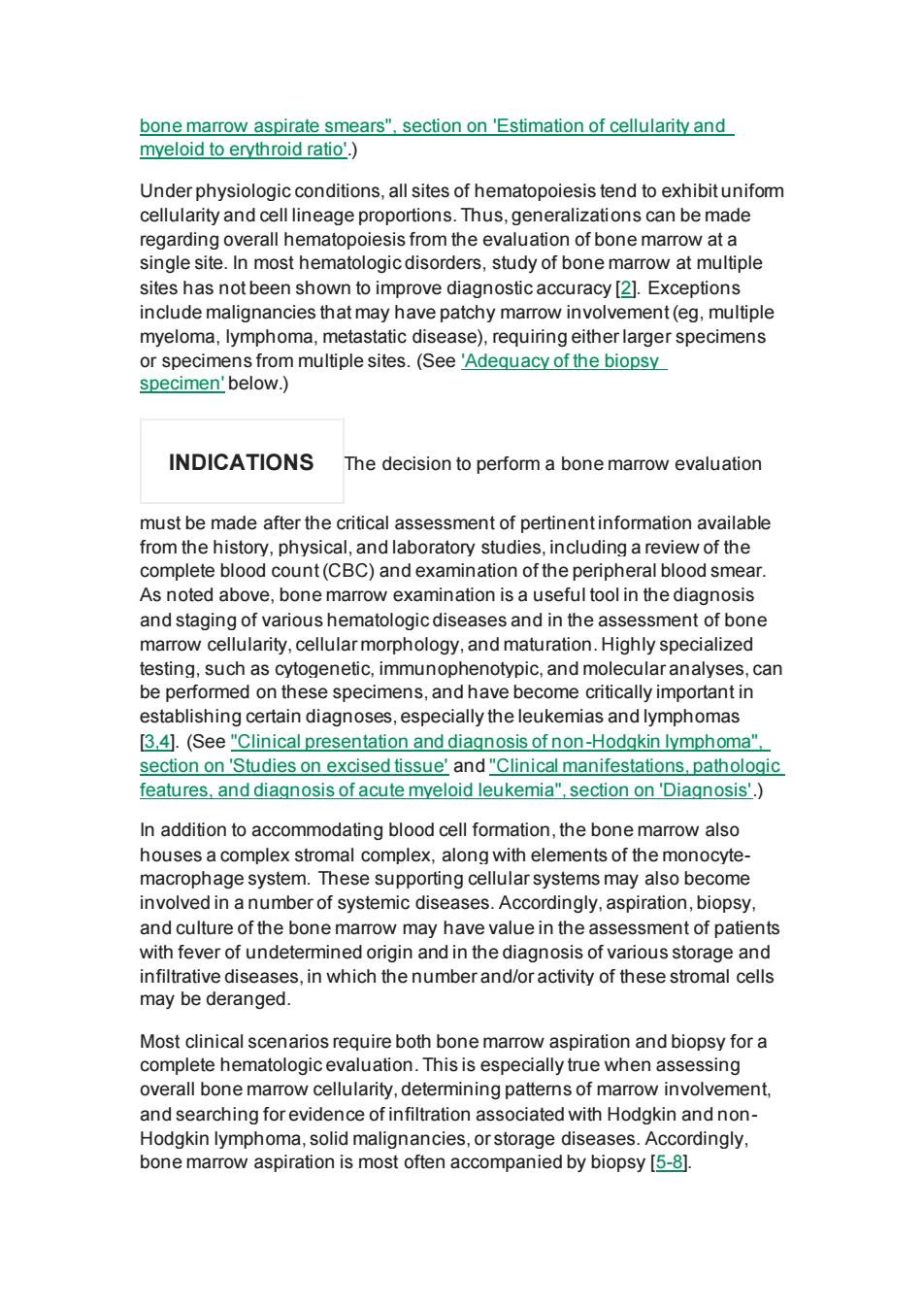正在加载图片...

Under physiologic conditions.all sites of hematopoiesis tend to exhibitunifom neralizations can be made regarding overall hematopoiesis from the evaluati of bone ma arrow at a single site.In most hematologic disorders,study of bone marrow at multiple sites has not been shown to improve diagnostic accuracy [2].Exceptions include malignancies that may have patchy marrow involvement(eg,multiple myeloma,lymphoma,metastatic disease),requiring either larger specimens or specim n multiple sites.(See'Adequacy of the biopsy INDICATIONS The decision to perform a bone marrow evaluation must be made after the critical assessment of pertinentinformation available from the history,physical,and laboratory studies,including a review of the unt(CBC)ande eral blood sme e bonemamrow sxamination isausetultoolin theds and staging of various hematologic diseases and in the assessment of bone marrow cellularity,cellular morphology,and maturation.Highly specialized testing,such as cytogenetic,immunophenotypic,and molecular analyses,can be pert rmed on the pecime ns,and hav become critically important in establishing certain diagnoses,especi ally the le kemias and [3,4].(See "Clinical presentation and diagnosis of non-Hodgkin lymphoma". section on 'Studies on excised tissue'and"Clinical manifestations.pathologic features,and diagnosis of acute myeloid leukemia",section on'Diagnosis'.) In addition to accommodating blood cell formation,the bone marrow also houses a complex stromal complex,along with elements of the monocyte- macrophage system.These supporting cellular svstems may also become involved in a number of systemic diseases.Accordingly,aspiration,biopsy and culture of the bone marrow may have value in the assessment of patients with fever of undetermined ongin and in the diagnosis of varous storage and infiltrative diseases,in which the number and/or activity of these stromal cells may be deranged. Most clinical scenarios require both bone marrow aspiration and biopsy for a complete hematologic evaluation.This is especially true when assessing overall bone marrow cellularity.determinina patterns of marrow involvement. sociated with Hodgkin and non bone marrow aspiration is most often accompanied by biopsy [5-8].bone marrow aspirate smears", section on 'Estimation of cellularity and myeloid to erythroid ratio'.) Under physiologic conditions, all sites of hematopoiesis tend to exhibit uniform cellularity and cell lineage proportions. Thus, generalizations can be made regarding overall hematopoiesis from the evaluation of bone marrow at a single site. In most hematologic disorders, study of bone marrow at multiple sites has not been shown to improve diagnostic accuracy [2]. Exceptions include malignancies that may have patchy marrow involvement (eg, multiple myeloma, lymphoma, metastatic disease), requiring either larger specimens or specimens from multiple sites. (See 'Adequacy of the biopsy specimen' below.) INDICATIONS The decision to perform a bone marrow evaluation must be made after the critical assessment of pertinent information available from the history, physical, and laboratory studies, including a review of the complete blood count (CBC) and examination of the peripheral blood smear. As noted above, bone marrow examination is a useful tool in the diagnosis and staging of various hematologic diseases and in the assessment of bone marrow cellularity, cellular morphology, and maturation. Highly specialized testing, such as cytogenetic, immunophenotypic, and molecular analyses, can be performed on these specimens, and have become critically important in establishing certain diagnoses, especially the leukemias and lymphomas [3,4]. (See "Clinical presentation and diagnosis of non-Hodgkin lymphoma", section on 'Studies on excised tissue' and "Clinical manifestations, pathologic features, and diagnosis of acute myeloid leukemia", section on 'Diagnosis'.) In addition to accommodating blood cell formation, the bone marrow also houses a complex stromal complex, along with elements of the monocytemacrophage system. These supporting cellular systems may also become involved in a number of systemic diseases. Accordingly, aspiration, biopsy, and culture of the bone marrow may have value in the assessment of patients with fever of undetermined origin and in the diagnosis of various storage and infiltrative diseases, in which the number and/or activity of these stromal cells may be deranged. Most clinical scenarios require both bone marrow aspiration and biopsy for a complete hematologic evaluation. This is especially true when assessing overall bone marrow cellularity, determining patterns of marrow involvement, and searching for evidence of infiltration associated with Hodgkin and nonHodgkin lymphoma, solid malignancies, or storage diseases. Accordingly, bone marrow aspiration is most often accompanied by biopsy [5-8]